The Friends of the Wildflower Garden, Inc.
Plants of the Eloise Butler Wildflower Garden
The oldest public wildflower garden in the United States

Common Name
Green-flowered Peppergrass (Common Pepperweed, Common Peppergrass)
Scientific Name
Lepidium densiflorum Schrad.
Plant Family
Mustard (Brassicaceae)
Garden Location
Upland
Prime Season
Late Sprinmg to Early Summer
Green-flowered Peppergrass is a native erect annual or biennial growing up to 20 inches high on stems that are usually smooth which branch above the base forming a bushy plant that can look wider than tall.
Leaves are of two types. A rosette of basal leaves usually forms first. These are up to 3 inches long and coarsely toothed or pinnatifid in shape, oblong or spatulate in shape and usually wither away by flowering time. The stem leaves are alternate, medium to sometimes deep green, linear to slightly wider above the middle section, with either a very short stalk or without stalks but not clasping the stem; margins are either entire or irregularly toothed, up to 2-1/2 inches long and very narrow.
The inflorescence is an elongating raceme, beginning as a dense rounded cluster of buds, then beginning to elongate as the first flowers mature and quickly form seed pods. The central rachis of the raceme has very short fine erect hairlike growths - trichomes - that are club shaped.
Flowers are 4-parted with green oblong sepals and either no petals or with white petals much smaller than the sepals. There are two stamens and a style from the 2-celled ovary.
Seed: Flowers form a green oval 2-celled seed pod, called a sicicle, that is flattened and notched at the top, not veined and usually without any hair. Pods can be up to 3mm high and 2.5mm wide, semi-rounded, and are widest beyond the middle. Each pod cell contains a single seed.
Varieties: A number of varieties have been described in the past. It is the opinion of Flora of North America (Ref. #W7) that the cases are weak and varieties should not be continued.
Habitat: Green-flowered Peppergrass grows from a taproot in a variety of soils and is found in disturbed sites and areas not subject to control or cultivation. It needs full sun but moisture conditions can be from moist to dry.
Names: The genus name Lepidium is from the Greek lepidion, meaning "a little scale," referring to the seed pod shape. The genus is entirely made up of the peppergrass plants. The species name densiflorum means "densely flowered." The author name for the plant classification ‘Schrad.’ refers to Heinrich Adolf Schrader (1767-1836), German botanist, who taught at the University of Gottingen and wrote Nova genera plantarum and Flora germanica. The genus Schraderanthus is named for him. The common name of Peppergrass, or sometimes Pepperwort, is applied to 42 species in North America and about 220 world wide. Thus determining which species being looked at requires checking a number of details. The foliage has a pepper taste from the various oils of the mustard family in the plant.
Similar plant or comparisons:: At one time 7 species of Peppergrass were reported in Minnesota. Only 4 are on the DNR plant survey. Two of those are introduced species - L. campestre and L. draba. Both have very limited known distribution. The third species L. virginicum subsp. virginicum, Virginia Peppergrass, is closest in comparison to L. densiflorum but is also limited in distribution being surveyed in only 7 counties, but several in the metro area. That species has seed pods widest below the middle, flower petals longer than the sepals and the trichromes are curved. It does not form a rosette.
Two other plants may confuse: First is Shepherd's Purse, Capsella bursa-pastoris. There the seed pods are triangular without wings, the upper leaves have auricles and the flowers have petals longer than the sepals. Second is Field Pennycress, Thlaspi arvense L., where the seed pods are more oval, the petals are longer than the sepals and the upper leaves have auricles. Comparison drawings are show below.
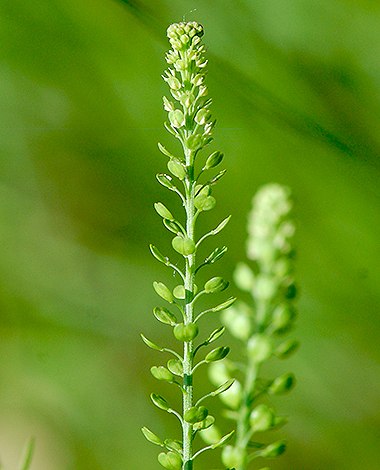

Above: In typical Mustard family fashion, seed pods are maturing at the base of the raceme while flower buds are still unopened at the top. Drawing from Britton, N.L., and A. Brown. 1913. An illustrated flora of the northern United States, Canada and the British Possessions. 3 vols. Charles Scribner's Sons, New York.
Below: 1st photo - flowers have sepals longer than the petals (if there are any), two stamens and a style are exserted. 2nd photo - the seed pods (sicicles) form rapidly. They have 2 chambers, a notch at the top with the style point at the base of the notch and are a bit wider just above the middle.
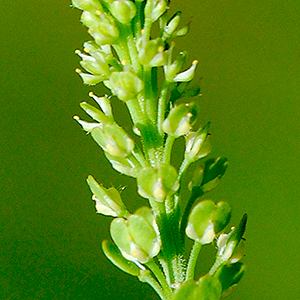
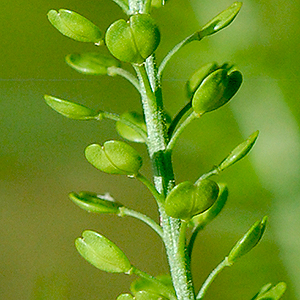
Below: A comparison of Field Pennycress (1st drawing) and Shepherd's Purse (2nd drawing); both drawings from Britton, N.L., and A. Brown. 1913. An illustrated flora of the northern United States, Canada and the British Possessions. 3 vols. Charles Scribner's Sons, New York.

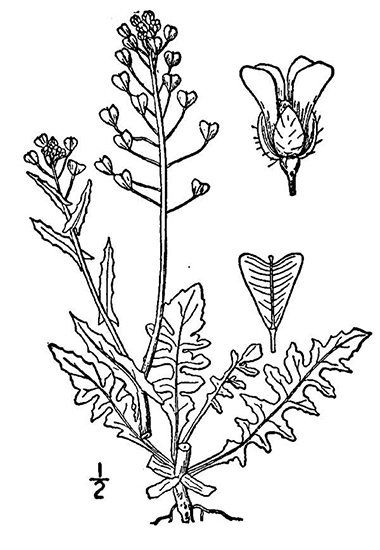
Below: The stem leaves are linear to slightly wider above the middle and may be entire or with shallow teeth as in this example.

Below: Green-flowered Peppergrass can produce a larger number of flowering stems.
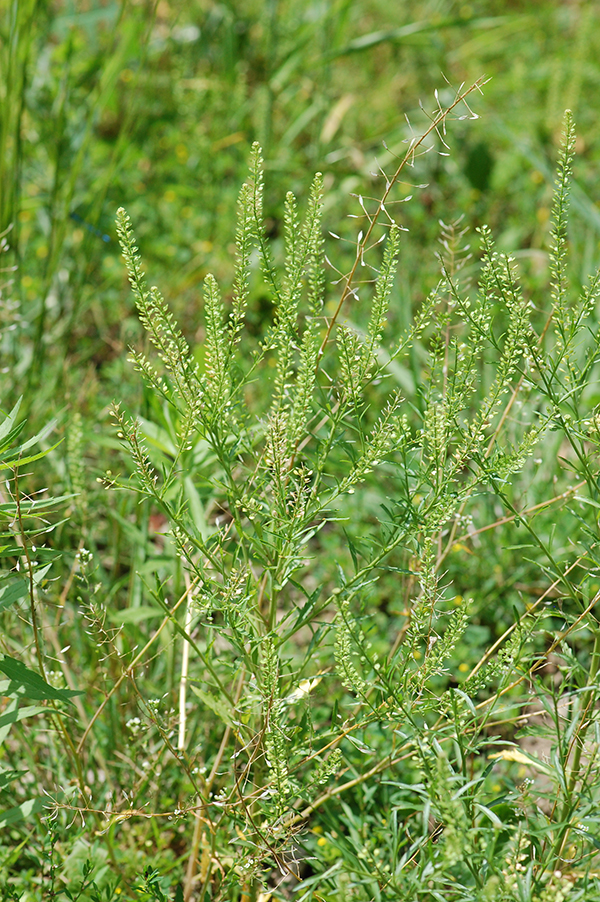
Notes: It is not known when Green-flowered Peppergrass came into the Garden. It has been listed on plant census reports back to 1986. There does not seem to be a record of Eloise Butler reporting it, nor Martha Crone, but Crone noted planting Virginia Peppergrass (L. virginicum) in 1949 but did not include it on her 1951 census two years later.
Green-flowered Peppergrass if widespread in Minnesota - only 7 counties do not report it. It is fairly widespread in the United States, only 7 states do not report it but it is not native to all areas.
Return to -- Site Plan/Archive Index --or-- List of Common Plant Names -- or -- List of Scientific Names -- or --Home Page - - - Back to top.
References: Plant characteristics are generally from sources 1A, 32, W2, W3, W7 & W8 plus others as specifically applied. Distribution principally from W1, W2 and 28C. Planting history generally from 1, 4 & 4a. Other sources by specific reference. See Reference List for details.
 Identification booklet for most of the flowering forbs and small flowering shrubs of the Eloise Butler Wildflower Garden. Details Here.
Identification booklet for most of the flowering forbs and small flowering shrubs of the Eloise Butler Wildflower Garden. Details Here.
©2020
Friends of the Wildflower Garden, Inc. Text and photos are by G. D. Bebeau unless otherwise credited. "www.friendsofeloisebutler.org"
011223